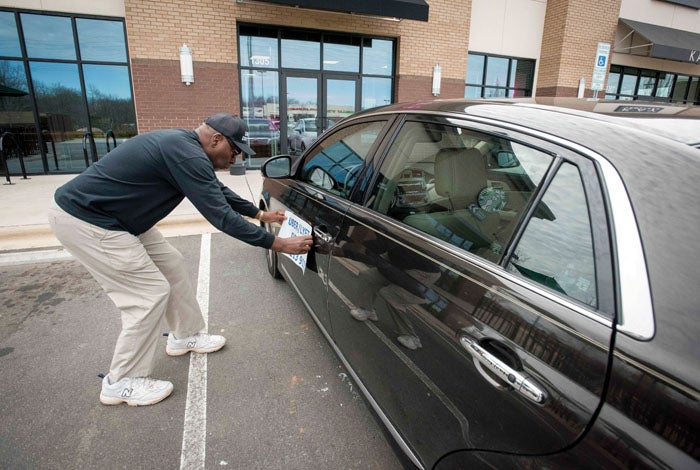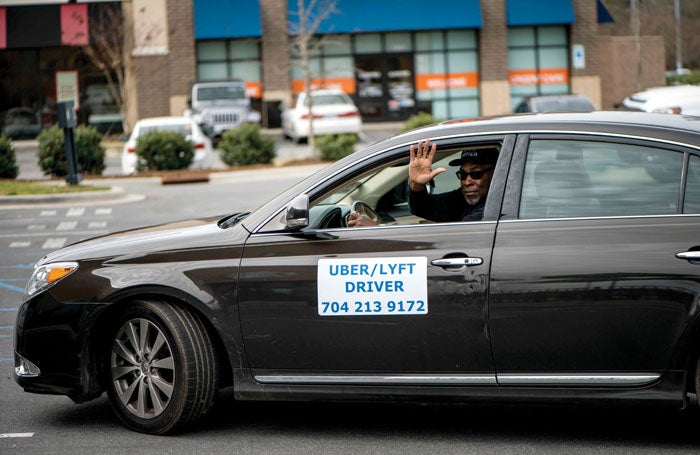In the Trenches: Uber-Lyft driver enjoys the ride
Published 12:00 am Wednesday, March 6, 2019
SALISBURY — Quentin Woodward Jr. is a tall man – 6 foot 2 and fit. His stoic demeanor may hearken back to his work in federal prisons. If you didn’t know, you’d never guess he’s over 70 years old.
Woodward is an Uber and Lyft driver, and he loves it.
Woodward graduated from N.C. Central University with a bachelor’s degree in sociology. He worked for 24 years in the Federal Bureau of Prisons.
“You get perceptions about people who you’ve never had interactions with. You meet them, sit down and talk, and learn about them,” Woodward says. “My mother was very stern. I never got into trouble.”
He says his job is to get people from Point A to Point B, but he tries to add value.
“It’s all about the ratings, so I try to give more.”
In the back seat of his 2011 Avalon, he carries a basket filled with things a traveler might need — bottled water, a mirror, a lint brush, chewing gum.
“My family lives in Charlotte,” he says. “I normally go there for Christmas. My niece purchased the basket for me, knowing I’m an Uber driver.”
He’s logged 1,193 trips in 20 months and has a 4.88 rating out of 5. Riders have commented that he’s a great driver, makes good conversation and has good amenities.
“I was in conversation with a friend who’s an established driver for Lyft. She told me about her experiences, and it seemed attractive — part-time hours and meeting people with various backgrounds; extra money and the freedom to be your boss. So I thought I’d give it a try.”
Woodward says he drives for both Uber and Lyft to expand his opportunities. He’s allowed to work for only one at a time. The app features are virtually identical, he says, though Lyft is slightly quicker to pay him.
Uber and Lyft are similar to taxis, but the drivers are not certified by a government authority. They typically drive their own cars. Uber requires that the car be not older than a decade. A potential driver goes through a criminal background search and must show proof of insurance to start work.
Woodward connects his bank account to his app so his payments can be deposited, minus a percentage for Uber or Lyft. Drivers can choose their own hours and start their workday simply by logging into the app. Soon they start getting “pings” to indicate riders want a lift.
“They provide you with tips,” he says. “And there are YouTube videos online to help you be more efficient and effective.”
A rider downloads the app and connects it to a credit or debit card so the driver can be paid. To get a ride, a user opens the app and allows it to identify his location. He enters his destination and within seconds, he’s advised a driver is on the way.
The app identifies the car model and license plate number for safety reasons. When a car pulls up, the rider can check the license against the one on his phone.
A ride, Woodward says, can be short or long. His longest fare was a truck driver who had just finished a trip at the local Love’s truck stop and wanted a ride home to Asheville.
“It was cloudy and rainy that day,” he says. “The signs on the way, the ones with electronic display, warned about low visibility. I was responsible for this rider, and I was scared, but I tried not to let him see.”
Other rides can be just five or 10 minutes long.
“The technology follows me with location tracking. A ride request always goes to the nearest available driver. In some instances, the ride goes farther away. Usually when I get a ping, the customer is just a mile or two away. Sometimes I get pinged from Statesville or somewhere because I’m the nearest.
“You never know who you’re going to meet,” he says. “Every day is different. Each passenger is different. Each personality is different. It’s really intriguing and something I really enjoy.
“I’ve been to Wal-Mart sometimes to pick up people. If they have a cart of groceries, I open the trunk for them. I don’t assist them; I don’t touch their things unless they want me to. But they appreciate me.”
To say Woodward is a sports fan is an understatement.
“I was in Winston-Salem one day and I had a request to go to the UNC School of the Arts. I had a call to take a woman to the airport. Turns out, she’s the wife of the VP of the Chicago Bears. She told me about her husband. He’s been with the Bears for 15 years.”
As a morning person, Woodward chooses not to drive late at night. He starts his day about 7 or 8 a.m. and works to early evening. Uber and Lyft provide graphs for drivers to determine peak times in their areas.
“Based on the graph, usage is highest in the morning, then it drops midmorning. It picks up again mid- to late afternoon. Of course, at night, people are headed to social events, but by then, I’m done for the day.”
Drivers must ensure their vehicles are road-worthy.
“Because I’ve accumulated a lot of mileage, I have to keep up with maintenance. I get regular oil changes. … I clean my car really often. You want to make a good appearance.”
He says even with the expense of fuel, cleaning and maintenance, it is a profitable job.
Woodward credits his prison experience for his success.
“I try to provide customer service to every passenger. In working with federal inmates, you must treat them with respect and listen to them.
“If there’s an opportunity for conversation, I will participate. Sports is safe. I do not get into politics or controversial topics.”
Woodward says he’s never been afraid, but he acknowledges, with a chuckle, that his appearance may ward off any threats. As nice as he is, he can look pretty intimidating.
“Uber provides a direct link to 911. There have been some isolated incidents in Charlotte where drivers have been assaulted. We have the ability to contact law enforcement if we feel threatened. Also, if you’re going to an area where you have a feeling you may not be safe, you have the option to decline the trip.
“Some riders look at me before they get in the car. They may ask, ‘Are you Quentin?’ But nine times out of 10, they know what kind of car I drive, what I look like, so they can be confident before they get in the car.”
Woodward uses Gas Buddy, another online app, to identify the cheapest gas in the area. He keeps his radio tuned low to classical station WDAV 89.9.
The worst days, he says, are spending hours and not getting a request.
“You know riders are out there. It goes in spells. Yesterday was back-to-back. Charlotte is a gold mine. Especially this week with the (CIAA) tournament, there are plenty of rides. I’m about 50-50 on driving. I’m more interested in the games.”
Driving for others is sometimes an exercise in minding one’s own business.
“Once I picked up two students from a hotel early in the morning. Now I knew there was no good reason for these two young people to be there at that time. In these cases, I don’t say much. I just greet them and confirm the destination.”
Woodward has taken the initiative to promote his business. He had custom shirts and caps embroidered at Ashley’s, a local embroidery shop. He’s had business cards printed, too, and keeps them stocked at the Courtyard Marriott, Holiday Inn Express, Love’s Truck Stop, Pilot Truck Stop, Comfort Suites and the Food Lion corporate office.
He says he regularly gets calls from them all and it’s been a good investment and use of his time.
“I picked up a gentleman one time, I could tell he was slightly inebriated. He continued to talk and talk. I had flashbacks to inmates. No problem. When you have the experience of working with federal and state inmates, dealing with all kinds of personality issues, you learn to be stern and direct. … They’re not going to be in my car very long, so I can withstand most anything.”
Moms with babies bring their own car seats, he’s learned. He drove a hearing-impaired woman and there was no conversation. He had her destination from the app. He’s had passengers who suffer from PTSD and bring their dogs along.
“I picked up a lady with a backpack once,” he says. “She was going to Sweet Frog. I turned around, and there was a dog in her backpack.”
His favorite passengers are college students. Their trips are usually short.
“I had some hard knocks. I know the value,” he says. “When I pick up students, I am more encouraging than anything else. I hope something I have said will stick with them. I give them eye contact and learn about them. I can get a feel about them sometimes. But you always remain professional.
“Working in the prison system, I was exposed to training that emphasized communication, professionalism, accountability. Those things I was taught I apply now in being an Uber driver. It’s very simple.
“Next month I’ll be 72. I don’t plan to stop. I know what it’s like to work 9 to 5, and I don’t plan to do that anymore. I pick up people who’ve had a hard day. I’ve been there, done that.”






